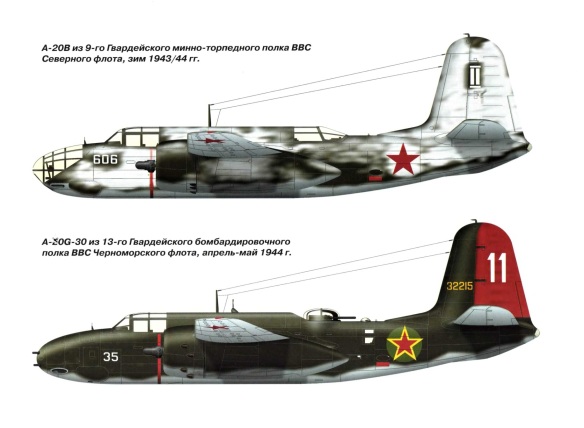The Soviet Union was actually the single largest user of the DB-7/A-20 series, receiving nearly half the total production. The USA reserved no less than 3125 DB-7Bs, DB-73s, DB-7Cs, A-20Bs, A-20Cs, A-20Gs, A-20Hs, and A-20Ks for delivery to the USSR under Lend-Lease. 2901 of these were actually delivered. In addition, substantial numbers of RAF Bostons were diverted to the Soviet Union. Many of the Soviet A-20s were ferried by air to Russia via Iran or Alaska rather than sending them via sea, where a number had been lost aboard ships to German U-boats.
Some of the Soviet A-20s had their rear gun positions replaced by a spherically-shaped Russian-built turret containing a single 12.7-mm Beresin BS machine gun. Soviet A-20s were used in just about every conceivable role, ranging from tactical support of armored units, to low-level strafers, to torpedo bombers. Unfortunately, little is known in the West about the service of Soviet A-20s. When the war ended, they were rapidly phased out of service.
Sources:
American Combat Planes, Third Enlarged Edition, Ray Wagner, Doubleday, 1982.
United States Military Aircraft Since 1909, Gordon Swanborough and Peter M. Bowers, Smithsonian, 1989.
McDonnell Douglas Aircraft Since 1920, Vol 1, Rene J. Francillon, Naval Institute Press, 1988
A-20 Havoc in Action, Aircraft Number 144, Squadron/Signal Publications, Jim Mesko, 1994.
Famous Bombers of the Second World War, William Green, Doubleday, 1960
Boston, Mitchell and Liberator In Australian Service, Stewart Wilson, Aerospace Publications, 1992.
Jane’s Fighting Aircraft of World War II, Military Press, 1989.
Dog of War, Peter M. Bowers, Wings and Airpower, Vol 26 No 1 (1996)
DB-73
A French variant very similar to BD-7B, which again were diverted to England as Boston Mk IIIs. Many of these were built under licence by Boeing. Events further overtook this shipment after the German attack on the Soviet Union and the Attack on Pearl Harbor, when many Bostons were sent to the USSR and many more retained by the USAAF for its own use. Twenty-two were also sent to the RAAF by the British.
DB-7C
A Netherlands variant intended for service in the Netherlands East Indies, but the Japanese invasion was complete before they were delivered. Part of this order was stranded in Australia on the so-called “lost convoy” and the first 31 Bostons were assembled at Richmond Airbase (NSW) and operated by 22 Squadron during the campaign against Buna/Gona and Lau on New Guinea. The assembley of these 31 was hampered by the manuals and instrument panels being completely in Dutch. The remaining aircraft in this order were sent to the Soviet Union under Lend-Lease which would receive 3,125 examples of different variants of the Douglas DB-7 series.
T30 triple launcher for 4.5 in (114 mm) rockets.
When shipments to the UK finally resumed, they were delivered under the terms of Lend-Lease. These aircraft were actually refitted A-20Cs known as the Boston IIIA.
A-20B
The A-20B received the first really large order from the US Army Air Corps: 999 aircraft. They resembled the DB-7A rather than the DB-7B, with light armor and stepped rather than slanted glazing in the nose. In fact, 665 were exported to the Soviets, so relatively few actually served with the USAAC.
A-20C
The A-20C was an attempt to standardize a common British and American version, produced from 1941. It reverted to the slanting nose-glass and had RF-2600-23 engines, self-sealing fuel tanks and additional armor. They were equipped to carry an external 2,000 lb (907 kg) naval torpedo. A total of 948 were built for Britain and the Soviet Union, but many were retained by the USAAF after Pearl Harbor. The Soviet A-20s were often fitted out with turrets of indigenous design.
A-20G
The A-20G, delivered from February 1943, would be the most produced of all the series – 2850 were built. The glazed nose was replaced by a solid nose containing four 20 mm (.79 in) Hispano cannons and two .50 in M2 Browning machine guns, making the aircraft slightly longer than previous versions. After the first batch of 250, the unreliable cannon were replaced by more machine guns. Some had a wider fuselage to accommodate a power driven gun turret. Many A-20Gs were delivered to the Soviet Union. The powerplant was the 1,600 hp (1,200 kW) R-2600-23. US A-20Gs were used on low-level sorties in the New Guinea theatre.
